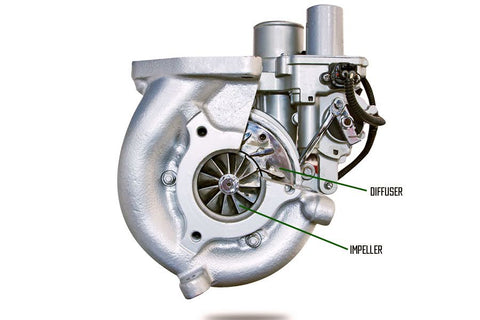Turbocharges, as internal combustion engines, are forced induction devices that improve vehicle performance. To ensure improved performance, turbos comprise several crucial parts, including a diffuser. But what is the function of diffuser in turbocharger?
Below, we will explore in more depth what the diffuser does in a turbocharger. So, let's dive in and discover its function!
Function of Diffuser in Turbocharger
The diffuser's function in turbocharged engines accelerates the exhaust gas flow. The diffuser also distributes it evenly in the turbine wheel.
Essentially, the diffuser has three roles:
- Bring in the air smoothly into the engine
- Slow the airflow before boosting the pressure
- Deliver equal flow to the compressor
In other words, the diffuser is the first turbo component the air encounters after initial intake. It ensures proper pressure and a smooth transition to improve engine performance.
If you're interested in turbochargers for sale, check out our page of used, rebuilt, and brand-new turbos!

Source: shutterstock.com / Photo Contributor: CHAINFOTO24
The diffuser
The main parts of a turbo are the turbine, compressor, and center housing hub assembly. The compressor component draws in the outside air through the intake systems.
The compressor pressurizes the intake air and feeds it into the combustion chambers. To do all of this, the compressor component is made up of the following parts:
- Impeller (compressor wheel or turbine wheel)
- Diffuser
- Volute housing
Impeller
The impeller is a crucial part of a turbocharger's system, also known as a compressor or turbine wheel. The compressor and turbine sides of the turbocharger connect by a tube that holds the turbocharger impeller in place.
The tube and impeller spin when the hot exhaust gasses move over the turbine. The turbine is attached to the engine's exhaust system. The engine's intake system links to the turbocharger's compressor side.
This increases the air's density and permits the engine to burn more gasoline. The dimensions and form of the impeller blades play a crucial role in the turbocharger's operation.
Because of the blades' aerodynamic shape, the impeller can spin at high speeds without too much resistance. The turbocharger impeller works in a high-pressure, high-temperature setting.
Diffuser and volute housing
The air's optimal path from the compressor wheel to the compressor cover volute is what the diffuser is. The diffuser is the path rather than a physical component.
The purpose of the diffuser is to convert the air that exits the compressor wheel at a high speed. After that, it compresses it into static pressure when it fills the volute.
For the air exiting the compressor wheel to be affected by the diffuser, it must have a minimum diameter. The appropriate diameter ensures the pressure affects the air.
Diffuser ring in turbocharger
An entrance bleed of air from the compressor wheel is possible through a ring cut around the compressor eye inlet. This is also known as the diffuser ring.
When the compressor is running near a surge point, the inducer inlet bleed aids in stabilizing the airflow. When a compressor runs near its minimal flow at a specific pressure ratio, it can become unstable.
Some unstable airflow may lead to overheating and poor engine performance. In order to stabilize the airflow, the inducer bleed contributes to smoother engine operation.

Source: shutterstock.com / Photo Contributor: Andriy-Chik
Conclusion
As we mentioned, the function of diffuser in turbocharger is to bring the air smoothly into the engine. The diffuser is a crucial component of a turbocharger's proper function.
The diffuser also slows down the intake of air. After that, it increases the pressure and delivers uniform airflow. The diffuser's function ensures the turbo gives the power needed for better performance.



